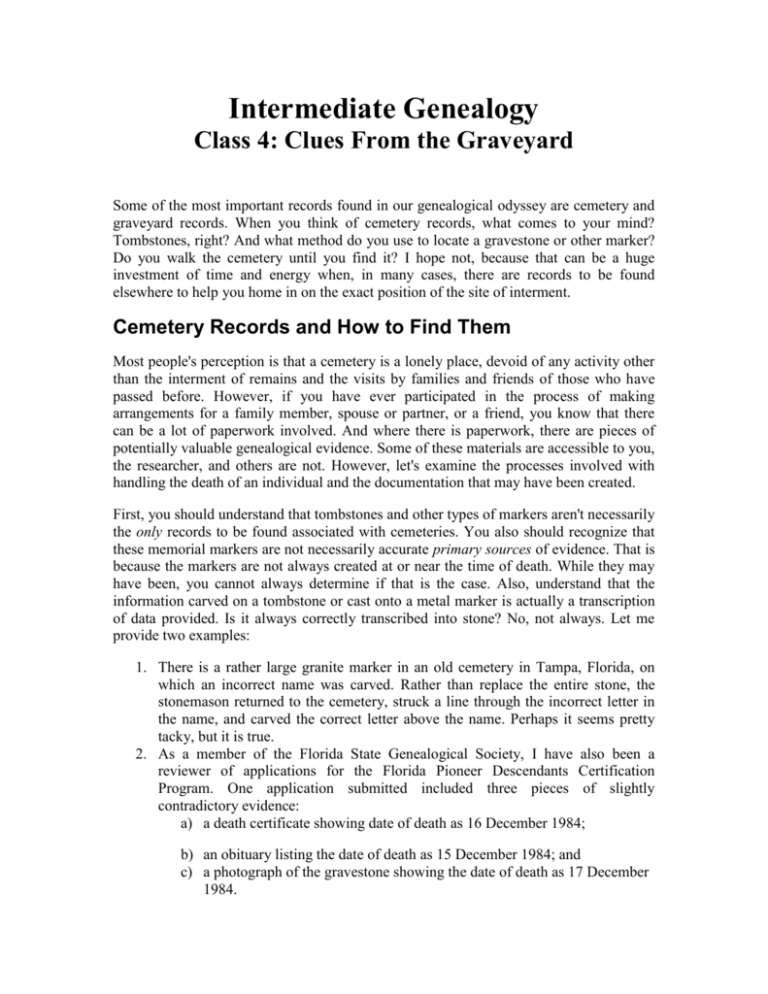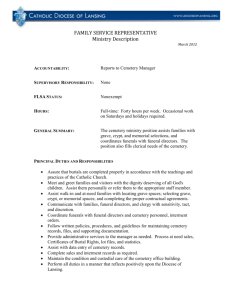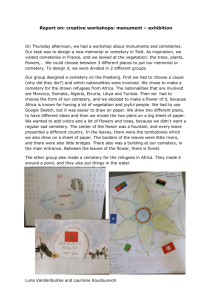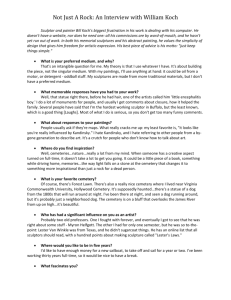
Intermediate Genealogy
Class 4: Clues From the Graveyard
Some of the most important records found in our genealogical odyssey are cemetery and
graveyard records. When you think of cemetery records, what comes to your mind?
Tombstones, right? And what method do you use to locate a gravestone or other marker?
Do you walk the cemetery until you find it? I hope not, because that can be a huge
investment of time and energy when, in many cases, there are records to be found
elsewhere to help you home in on the exact position of the site of interment.
Cemetery Records and How to Find Them
Most people's perception is that a cemetery is a lonely place, devoid of any activity other
than the interment of remains and the visits by families and friends of those who have
passed before. However, if you have ever participated in the process of making
arrangements for a family member, spouse or partner, or a friend, you know that there
can be a lot of paperwork involved. And where there is paperwork, there are pieces of
potentially valuable genealogical evidence. Some of these materials are accessible to you,
the researcher, and others are not. However, let's examine the processes involved with
handling the death of an individual and the documentation that may have been created.
First, you should understand that tombstones and other types of markers aren't necessarily
the only records to be found associated with cemeteries. You also should recognize that
these memorial markers are not necessarily accurate primary sources of evidence. That is
because the markers are not always created at or near the time of death. While they may
have been, you cannot always determine if that is the case. Also, understand that the
information carved on a tombstone or cast onto a metal marker is actually a transcription
of data provided. Is it always correctly transcribed into stone? No, not always. Let me
provide two examples:
1. There is a rather large granite marker in an old cemetery in Tampa, Florida, on
which an incorrect name was carved. Rather than replace the entire stone, the
stonemason returned to the cemetery, struck a line through the incorrect letter in
the name, and carved the correct letter above the name. Perhaps it seems pretty
tacky, but it is true.
2. As a member of the Florida State Genealogical Society, I have also been a
reviewer of applications for the Florida Pioneer Descendants Certification
Program. One application submitted included three pieces of slightly
contradictory evidence:
a) a death certificate showing date of death as 16 December 1984;
b) an obituary listing the date of death as 15 December 1984; and
c) a photograph of the gravestone showing the date of death as 17 December
1984.
d)
So, in both the examples above, how do you determine what is correct? Let's examine
several types of documents associated with death and interment, what information you
are likely to find on them, and where you are likely to locate them.
Type of Document
and Description
of Its Use
Death Certificate - Used to
document a death. It is an
excellent primary source for
death information, but a
secondary source for all
other information. Death
certificates may not exist in
many places prior to 1900.
Consult Ancestry's Red Book
for specifics in U.S.
Coroner's Report - Used to
document cases of unusual,
suspicious, or accidental
death.
Transit Permit - Used to
document the movement of
the deceased's remains from
one political jurisdiction to
another, i.e., state-to-state or
country-to-country.
2
Cemetery-Related
Information You Likely
Will Find on the Document
Where You Are
Likely to Locate the
Document
Date and place of death
Name of mortuary or
funeral home handling body
Name and location of the
place of interment
County department of
health
County courthouse
State department of health
or vital statistics
Mortuary or funeral home
records
Files of the cemetery
administrator or sexton
Date and place of death
Cause of death
Name of mortuary or
funeral home handling the
body
Name(s) of investigating
officials
Final determination
Office of the coroner or
medical examiner
Courthouse with
jurisdiction over location of
death at the time
Probate court records
Other court records
Date and place of death
Cause of death
Sometimes includes the
address and age of the
decedent
Name and location of the
originating mortuary or
funeral home
Name and location of the
destination mortuary or
funeral home
Sometimes includes the
name and location of the
place of interment.
Government office of the
place of origin of the body's
departure
County department of
health
County courthouse
State department of health
or vital statistics
Mortuary or funeral home
records
Files of the cemetery
administrator or sexton
Burial Permit - Used to
record the opening of a grave
and allow the inter- ment of
remains. This may be issued
by the govern- ment entity
which had ownership and
administra- tive control of
the cemetery.
Interment Ledger - Used in
some cemeteries in older
times to record interments
Cemetery Lot Deed - Used
to record the sale of a
cemetery lot and sometimes
the sale of individual plots
Name of the deceased
Date and place of death
Name of cemetery
Interment location (lot
and plot identity, tomb or
mauso- leum identity, or
columbarium identity)
Scheduled date of
interment
Name and location of
mortuary or funeral
home
Sometimes name of the
person or company
authorized to open and
close the grave
Authorizing agency,
signature, and date of
issue
Issuing agency, usually
the owner or
administrator of a
municipal-, county-,
state-, or federal-owned/
operated cemetery.
Files of the mortuary or
funeral home
Files of the cemetery
administrator or sexton
for the cemetery
For military service
personnel, seek a permit
for a burial in a military
cemetery in the
individual's military
personnel file
Name of the deceased
Office of the cemetery
Date of death
administrator or sexton for
Sometimes includes the
the cemetery
cause of death and location
Location of interment in the
cemetery
Date of interment
Name of purchaser
Name of seller
Date of the sale
Location and description of
the lot (or plot)
Amount paid for the parcel
Office of the cemetery
administrator or sexton for
the cemetery
May also be recorded in
county clerk's office along
with other property records
May find a copy in the files
of the mortuary or funeral
home which handled the
arrangements, particularly if
this was the first interment in
the lot
Obituary - Used to publicly
announce a death, location,
and date(s) of arrangements
3
Public Notices - Used to
advertise a death, and both
the collection of debts for the
estate and to request
presentation of claims
Cemetery Canvasses and
Gravestone Transcription
Projects - Compilations and
publications to record the
interments in a cemetery or
other place of interment for
posterity
Name of deceased
Date and location of death
May contain extensive or
abbreviated information
about the person's life,
survivors, and other personal
information
Date and location of funeral
or other services
Location of interment
Newspapers, church
bulletins and newsletter
(local and regional), union
and fraternal organization
publications, professional
publications
Libraries and archives with
microfilmed holdings of the
above publications
Internet-based obituary
transcriptions
Name of deceased
Date of death and residence
Name of administrator
Sometimes place of death
and place of interment are
listed if different than place
of residence
Newspapers
Libraries and archives with
microfilmed holdings of the
newspapers
Estate and probate packets
Probate court minutes
Any information inscribed
or cast onto a tombstone or
other grave marker
May or may not be allinclusive, including epitaph
May or may not include
photographs
May or may not be
published
Genealogical societies in
the area and at the state level
Historical societies as
above
Libraries and archives
Genealogy society
periodicals, which can be
located using the Periodical
Source Index (PERSI) online
at Ancestry.com and then
ordered from genealogical
libraries
County and Local Histories
- Used to record information
May contain a variety of
of historical significance in a information about
specific geographical area
individuals, families, ethnic
groups, and other facts to
help you locate religious,
public, private, and family
places of interment
Genealogical societies in
the area and at the state level
Historical societies as
above
Libraries and archives
Military Histories and
Regimental Histories Used to record information
of historical significance
relating to a specific military
event or military unit
Military Service Papers Records used to document
the military service and
pension information for an
individual
4
Funeral or Condolence
Books - Provided by the
mortuary or funeral home to
allow persons visiting the
family of the deceased to
sign their name and write a
message
Web Sites - Many Web sites
contain information related
to places of interment
May contain a variety of
information about
individuals serving in the
military, their families,
ethnic groups, and other
facts to help you locate
religious, public, private,
family, and military places
of interment
May contain a variety of
information about an
individual and his or her
military service. May also
include information about
death benefits paid and
interment in a military
cemetery in the U.S. or
abroad
May contain a variety of
information, but also may
specify date and location of
interment
Genealogical societies in
the area and at the state level
Historical societies as
above
Libraries and archives
Military service and
pension files (different
locations)
American Battle
Monuments Commission
Web site (for WWI, WWII,
Korean War, and Vietnam
War) at
http://www.abmc.gov
Family effects
The Internet contains a
wealth of information
Ancestry.com databases
concerning deaths and
(http://www.ancestry.com)
interments, and using a
RootsWeb databases
search engine can be of some (http://www.rootsweb.com)
assistance
USGenWeb Project
(http://www.usgenweb.org)
WorldGenWeb Project
(http://www.worldgenweb.or
g)
United States Geological
Survey's GNIS Site Contains vast information
for use in locating a variety
of geographical sites
Completely searchable
database of geographical
features by name, location,
and/or type. A search for a
feature type of cemetery or
church can help you locate
specific locations for
cemeteries. You will then be
able to locate latitude,
longitude and other
information, as well as
display and print maps of the
location
USGS GNIS Web site
(http://geonames.usgs.gov)
select the link to GEOnet
Names Server (GNS) on
that page, and then the
Geographic Names
Information System
(GNIS) on the next screen.
As you can see, there are many different places to search for cemetery- and grave-related
information. What you will find, however, is you will be working a number of these
resources in tandem with one another. Let me provide you with an examples of research I
conducted in Rome, Georgia (Floyd County).
Example:
I was searching for the burial location of my great-grandparents, Green Berry HOLDER
and his wife, nee Penelope SWORDS. I knew they were buried in Rome, Georgia, in the
Myrtle Hill Cemetery. Prior to my first on-site visit, I conducted research using the USGS
GNIS Web site to determine the exact location of the cemetery. Next, I contacted the
Rome City administrative offices to determine who was responsible for the cemetery's
administration and maintenance. I was directed to the Rome Cemetery Department,
which is responsible for all five of the municipal cemeteries. The sexton of the Myrtle
Hill Cemetery was able to pull the records for Green Berry HOLDER, and could tell me
the following:
5
the date of the original purchase of the cemetery lot;
the identification information of the lot (lot number and location);
the names of each person buried in the lot, their date of death, their ages, and the dates
of their interments; and
the date on which two plots in the lot were resold to the owner of an adjacent lot.
An inquiry about a great-uncle whom I thought was buried in that cemetery also revealed
that his wife was buried there. However, I learned that he was buried in another
municipal cemetery beside another woman bearing his surname -- a second marriage
about which neither I nor anyone else in the family was aware.
Based on this information, I had a much better idea of what information I would be
seeking about those family members interred there. I also had information about
approximate dates of death. I now followed those clues to the Floyd County Health
Department to obtain copies of all the death certificates. Those led me to other clues,
including to the current owner of the funeral home.
I also visited the local public library where I researched microfilm of newspapers to
obtain obituaries. Had I seen the obituary of the great-uncle earlier, I would have known
he was buried in the other cemetery and that he was survived by his second wife.
An onsite-visit to the cemetery sexton's office provided me the opportunity to see the
physical files maintained there. For my great-grandmother, Penelope Swords HOLDER,
there was no death certificate. However, there were copies of her obituary, a burial
permit, and a note to the sexton from my great-grandfather asking that my greatgrandmother be buried in a specific plot adjacent to one of their grandchildren. In
addition, the current sexton checked the interment ledger and found recorded there the
cause of death -- pneumonia. This was important because there were no death certificates
issued there at the time, and this answered another question I had about her.
As I emphasized at the outset of the class, you will want to be creative in your use of
records. You will also want to search out multiple records and record types because each
one will corroborate (or refute) another. Each record also has the possibility can add a
little further data and insight into your ancestor or family member and his or her life. The
example above shows how records can be used in tandem with one another in this way,
and how researching one piece of information can lead you to others.
Reading the Tombstone
Reading a tombstone or other marker might seem an easy thing to do. However, there
may be some additional things you may not know. I want to offer you a few tips.
6
1. Read every word on the marker. If something is in a foreign language, copy it in its
entirety, exactly as inscribed, and make sure you obtain an accurate translation later.
2. Check the back side of every tombstone. Sometimes there is additional information to
be found there. Examples might include a poem, birthplace and date, immigration and/or
naturalization information, military service unit and rank, names of other family members
and/or relationships, and any number of other data.
3. Make note of the positions of each burial in a lot. The burial of a spouse on one side or
another may be indicative of a relationship. Burial of a child away from one or both
parents may indicate some estrangement in the family. (Check wills and probate records
for perhaps other indications.)
4. Make a note of the family names of the burial plots in each direction from those of
your family. Family members often purchased adjacent lots, and even arranged to
purchase individual plots from adjacent lot owners so as to be buried next to their family
members for posterity. Names may not make any connection now, but you may later find
that an adjacent family was related by marriage to yours.
5. Make note of the epitaph. An epitaph is seldom chosen at random; it usually is selected
by the deceased or his/her family to reflect something about the person. An epitaph may
well be a descriptor of the person's personality.
6. Learn more about the images on the markers of your family members, also referred to
as iconography.
Cemetery Iconography
As you visit cemeteries, I am certain you have admired the gravestones and monuments
and the artistic carvings on them. But did you know that most of these designs represent a
specific concept of belief, death, and the afterlife? There is an whole set of symbology
relating to death, ranging from the seemingly macabre skull and crossbones to the gentle
image of a dove. And there are a wide variety of icons and graphics representing these
concepts.
For more information on cemetery iconography, you will want to refer to the following
articles and Web sites:
"Cemetery Iconography" by George G. Morgan
http://www.ancestry.com/library/view/columns/george/868.asp
The Olive Tree Genealogy: Grave Symbols
http://olivetreegenealogy.com/misc/grave_symbols.shtml
Christian Symbols as Seen on Grave Monuments
http://www.tngenweb.org/darkside/christian.html
GraveNet's "Gravestone Symbolism"
http://www.edutel.org/gravenet/gravenet_symbols.html
7
Tombstones & Monumental Inscriptions
http://gye.future.easyspace.com
How to Clean a Stone for Reading and Photographing It
Perhaps one of the more controversial subjects of discussion among family history
researchers is how to clean tombstones and markers. There are those who take an
aggressive approach and attack the task with rubber gloves, wire brushes, bleach, lime
removers, sandpaper, paint scrapers, and screwdrivers. Yes, you should be cringing!
Others take a more rational, preservationist approach to the process.
What any cemetery aficionado and/or researcher must recognize is that tombstones are
not forever. The elements of nature and the environment will ultimately erode the surface
of every gravestone or marker. Those who considered marble the height of elegance a
century ago would be saddened today to see their family markers crumbling to dust and
the inscriptions rendered nearly illegible by acid rain, moss and lichen, and extremes of
temperature variation.
'Gentle' is the watchword for cleaning and preserving stone markers, and this applies
when considering how best to obtain that oh so perfect photograph for your research
collection.
The Association for Gravestone Studies is an organization promoting preservation
through education. Their Web site at http://www.gravestonestudies.org contains a wealth
of information on the subject of cleaning and preservation. For a good primer on what TO
USE for cleaning stones, please read their FAQs concerning cleaning techniques and
non-injurious cleaning solutions at http://www.gravestonestudies.org/faq.htm.
To Rub or Not to Rub?
Tombstone rubbing has been a popular activity for centuries. The images have become
highly desirable works of art, as well as 'take-home' memorial remembrances from one's
own family burial places. However, making rubbings of tombstones has some severe
repercussions.
Making a rubbing may damage or destroy a marble or sandstone tombstone, causing it to
crack, crumble, or splinter. The process of making a rubbing may be dangerous or fatal,
especially if a delicate stone monument breaks and falls during the process.
In some locations, making rubbings has been outlawed, and making one is considered a
criminal activity. Some places in England and the U.S. no longer permit rubbings to be
made, and may prosecute individuals apprehended for destruction of property, vandalism,
or other charges. The imposition of stiff fines and sentencing of individuals to community
service has become common. The point is, be attentive to the postings of signs, and check
with local cemetery administrators and sextons before starting to make a rubbing.
To learn more about the DOs and DON'Ts of tombstone rubbings, refer to the references
below.
Reading Assignments:
"Locating People in Cemeteries" by George G. Morgan
http://www.ancestry.com/library/view/columns/george/2232.asp
"Visiting Cemeteries" by Juliana Smith
http://www.ancestry.com/library/view/news/articles/619.asp
"A Visit With a Cemetery Administrator" by George G. Morgan
http://www.ancestry.com/library/view/columns/george/2325.asp
"Carved in Stone: Clues in the Graveyard" by Karen Frisch
http://www.ancestry.com/library/view/ancmag/2974.asp
"Cemetery Research Online" by George G. Morgan
http://www.ancestry.com/library/view/columns/george/4636.asp
The Association for Gravestone Studies: FAQ of "Some Gravestone Rubbings Dos and
Don'ts"
http://www.gravestonestudies.org/faq.htm
"How to Do Gravestone Rubbings: Do No Harm"
http://members.aol.com/TombView/rubbings.html
Saving Graves: How to Do Gravestone Rubbings
http://www.savinggraves.com/education/rubbings.htm
You can locate other resources by using your Web browser and your favorite search
engine.
9 10
Assignments:
Your assignments for this lesson are relatively simple ones. They will require a little
investment of your time, especially the third one.
First, use the United States Geological Survey's GNIS Web site described in this lesson to
locate one or more cemeteries you have visited in the past. Then, use the site to locate a
cemetery you might like to visit on a research trip.
Second, locate three (3) Web sites that discuss and/or illustrate gravestone icons. Make a
list of five (5) icons from each of the Web sites. Describe in writing the icon and what it
usually represents. This document will become a handy reference for your next cemetery
research trip.
Third, make a visit to the nearest cemetery, regardless of whether you have family
members buried there or not. Take a friend or family member with you. Make a note of
three (3) things about the cemetery that you think you might not have known or
recognized before reading this lesson, or any new discovery or observation you made.
Share the information with your companion, and then post your list on the Reviews area
of our Web site.
© Copyright 2002, George G. Morgan.
All rights reserved.







